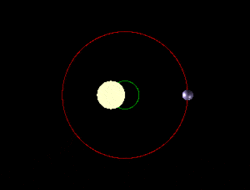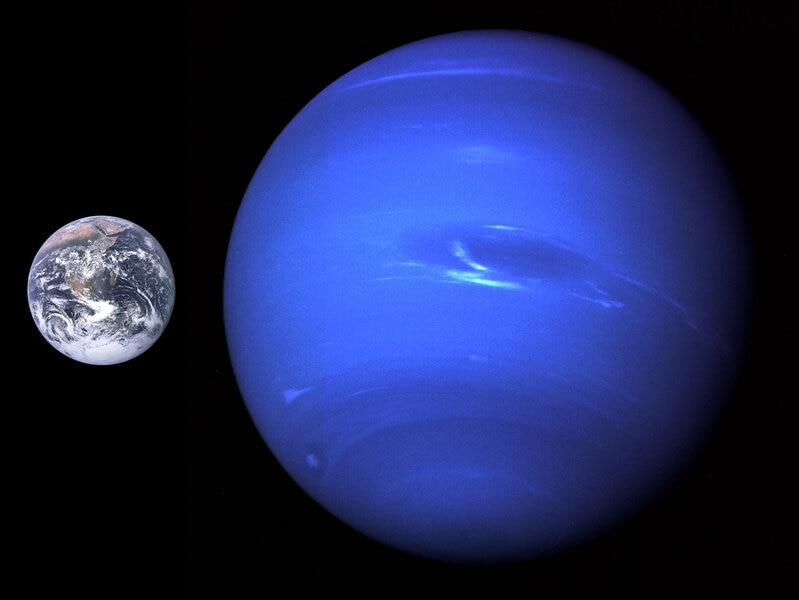Create a free profile to get unlimited access to exclusive videos, sweepstakes, and more!
Twin super-Earths around a nearby star make our solar system look weird

The more papers I read about "strange" exoplanets, the more I realize we're the strange ones.
In 2015, astronomers reported the discovery of a planet orbiting the nearby star K2-18. The planet, called K2-18b, was seen to transit the star; that is, we see its orbit edge-on, so once every orbit it passes directly between us and the star, blocking a percentage of the starlight. That dip in brightness was detected by the Kepler observatory (which had its mission extended and renamed to K2, hence the star's name). The planet's existence was confirmed with follow-up observations using the Spitzer Space Telescope.
This caused some excitement in the astronomical community. For one thing, K2-18 is a red dwarf, a small, low-mass, dim bulb of a star … but the most common kind of star in the Milky Way (and presumably the entire Universe). 80% or so of all stars in our galaxy are red dwarfs. K2-18 is also nearby, just about 110 light-years away. That's close in astronomy terms; bright enough to observe pretty easily.
Also, the planet has an orbital period of about 33 days, putting it about 22 million kilometers from the star. That's far closer than Earth is to the Sun, but remember, K2-18 is dim. When you crank the numbers, you find that K2-18b receives about the same amount of light and heat from its star as we do from the Sun. That puts the planet in the star's "habitable zone," the region around it where a planet can be warm enough for liquid water to exist on its surface. If you're searching for worlds with the potential for life, K2-18b isn't a bad place to keep in mind.
The transit also gives the size of the planet: It's about 2.3 times wider than Earth. That's pretty big, but still significantly smaller than Neptune. Planets like this are called Super-Earths, and if they get much bigger they become mini-Neptunes. It depends on just how big they are and how thick their atmosphere is. That's hard to figure out (or even guess at) until you know the planet's mass, which a transit doesn't reveal.
So astronomers used the High Accuracy Radial Velocity Planet Searcher (HARPS) spectrograph to observe K2-18. This instrument can detect extremely small shifts in the light from a star as a planet orbits it, looking for the Doppler shift in the starlight as the planet tugs on the star. This yields the planet's mass, and what they found is very intriguing: The planet has a mass of roughly 8 (±2) times Earth's mass.
Why is that so very interesting? Because it lets us figure out the planet's surface gravity and its density. The surface gravity is about 1.5 times ours; if you weighed, say, 100 pounds here you'd weigh 150 there. Uncomfortable, but livable.
The density turns out to be about 3.7 ±0.9 grams per cubic centimeter, less than Earth's density of 5.5 gm/cc. Earth is mostly metal and rock, so this planet must be made of somewhat lighter stuff. The uncertainty in the mass measurement limits what it can be made of; at the upper limit it could be rocky with water in the form of ice on the surface and a thick atmosphere, or at the lower end it could be a water world, covered in a deep ocean of liquid water.
That's amazing! The problem is we can't really distinguish between these possibilities right now. The good news is that with the upcoming James Webb Space Telescope we will. That is due to launch in 2019, and can do what's called infrared transmission spectroscopy. When the planet transits the star, it blocks the light. But if the planet has an atmosphere, some of the light will leak through (that's the "transmission" part). Different atoms and molecules absorb different colors of light, so by analyzing what light gets through K2-18b's atmosphere and what doesn't, its composition can be determined!
So we may know soon what's what.
But there's more! Analyzing the HARPS data, the astronomers noticed another signal. It's not 100% certain, but the odds are very good there's a second planet there — K2-18c — and that it too is a super-Earth with about 7.5 times Earth's mass. Interestingly, it doesn't transit the star, so its orbit must be tilted a bit relative to K2-18b's. It doesn't take much, just a few degrees, to do that. The planets in our own solar system have orbital tilts that vary by a few degrees, so this isn't too surprising.
But take a step back and look at this system. We have a dinky star with two big Earth-ish planets orbiting it. We see this a lot with red dwarfs, in fact; they tend to possess multiple planets.
And now look at our solar system: We have four small terrestrial planets, then a big gap in mass between Earth and Neptune (which is about 17 times Earth's mass), then four giant gasbag planets. We don't have a super-Earth or a mini-Neptune!
Yet, when we look at the numbers, these are the most common kind of planet we find orbiting other stars! Why don't we have planets like that?
It's possible we did, once, when the solar system was young. But there's an idea that the influence of Jupiter's gravity caused them to smash into each other, destroying them. Most the debris was flung out of the inner system, and our four inner planets (Mercury, Venus, Earth, and Mars) were made from what was left, so they're smaller.
We don't really know. But this newly discovered system, so close by and ripe for follow-up study, may help us understand why our solar system seems to be so different from every other one we've found.
I've been an astronomer my whole life (an amateur and enthusiast since I was wee, then a pro, and now as a communicator), and for a big chunk of that time we didn't know of any planets around other stars. And as we started finding them, we were surprised at how different they were from us. Then, as we found more, that view changed and flipped; it's not that they're different from us, it's that we're different from them.
Personally, I rather like it when my perspective shifts like that, when my frame of reference gets shaken. It means I'm learning, and getting a better understanding of how things really are.
It's literally, in this case, a change in worldview. That's a huge lesson of science: The more we learn, the more we find our previous views need to adapt. I think that's something we could all use every now and then.




























